How Anganwadis In Tamil Nadu & Kerala Are Showing Better Results
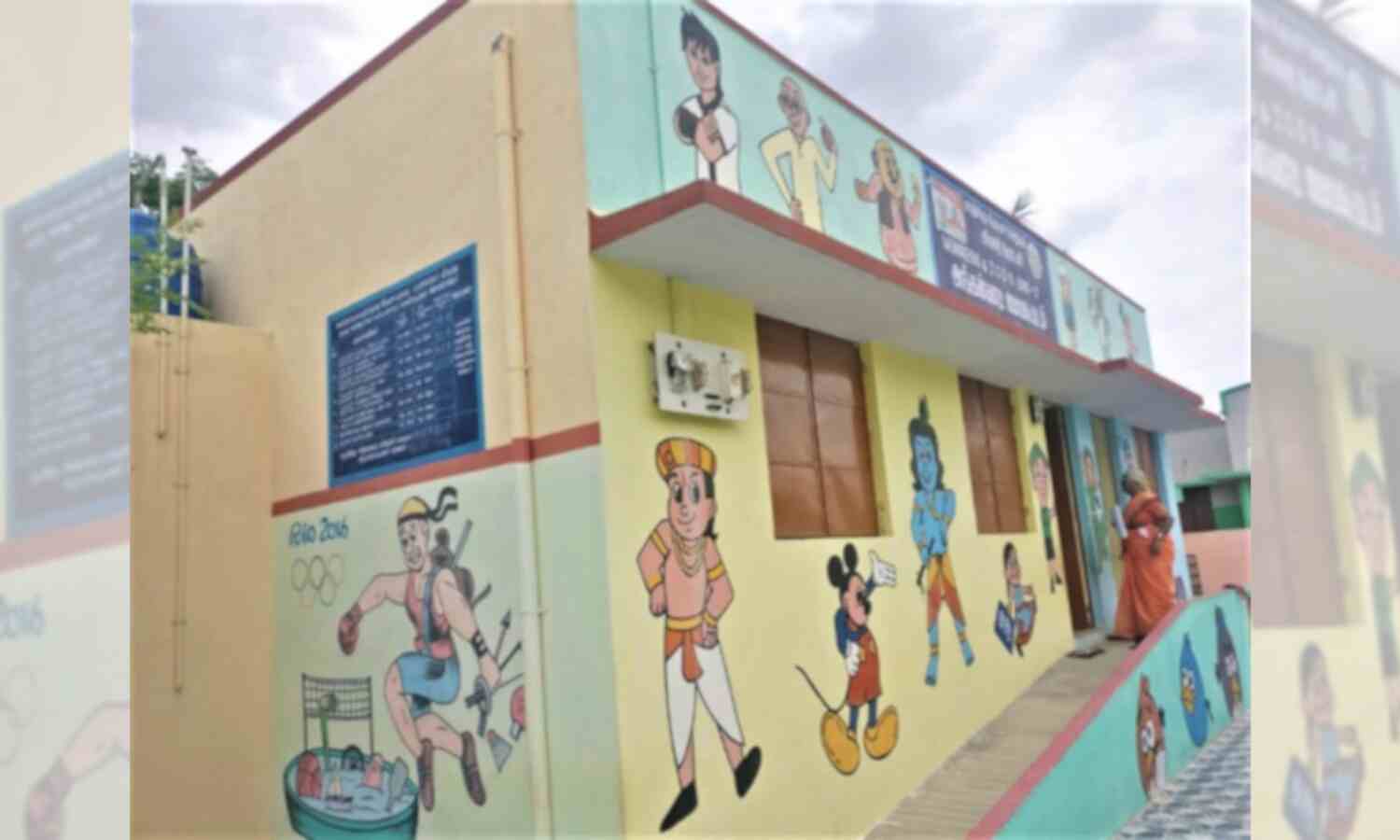
Sriperumbudur, Tamil Nadu: The anganwadi (childcare centre) in Sriperumbudur block in Tamil Nadu’s Kancheepuram district makes for a pretty picture. The walls are pastel shades of pink and yellow and are dotted with colourful posters of fruits and vegetables, flowers, names of months and days, and other informative charts. Toys and learning tools are neatly stacked at the back and one corner appears to be the designated science section.
Twenty children are reciting a poem in unison. The aroma of sambhar and rice wafts in from the attached kitchen. Outside the building, a small patch has been cultivated to grow vegetables and herbs. The evident quality of infrastructure and management in this anganwadi is unique--most anganwadis across the country are not similarly equipped.
Initiatives such as comprehensive training and engaging with and mobilising communities have helped boost the performance of anganwadi centres in Kerala and Tamil Nadu, we found, as part of a project to document innovations in maternal and child healthcare and nutrition across 50 programmes. Their cost- and resource-effective solutions hold lessons for centres nationwide, which are beset with vacancies, training gaps, high absenteeism ghost beneficiaries, and infrastructural and logistical challenges.
Anganwadis provide supplementary nutrition, pre-school education, health and nutrition guidance, immunisation, health check-ups and referral services to 88 million beneficiaries--children below the age of six, and pregnant and lactating women. The centres operate under the Integrated Child Development Services (ICDS) programme, launched in 1975 to combat malnutrition. Yet, India is home to 46.6 million stunted children (short for their age; one-third of the number worldwide) and 25.5 million wasted children (low weight for their height), according to the Global Nutrition Report 2018. Both conditions lead to increased mortality, especially when present in the same child.
The two primary modes for early childhood care and development in India are anganwadis and private preschools. This emphasis on early childhood care and development is critical as it addresses the social, emotional, cognitive and physical needs of a child.
Motivating anganwadi workers
Kerala and Tamil Nadu have charted a robust career trajectory for anganwadi workers to reduce attrition and improve functioning. Over and above the basic salary, workers are provided provident fund, maternity leave and other benefits.
In Tamil Nadu, anganwadi workers are entitled to six months’ paid maternity leave, medical allowance of Rs 100 per month, pension on retirement, and benefits of voluntary retirement. In Kerala, anganwadi workers get benefits such as pension, free medical care, and allowances for house-building, festivals and serious disease.
In both states, an anganwadi helper can be promoted to the post of an anganwadi worker. An anganwadi worker who is a graduate, after 10 years of experience and on passing the State Commission examination, can be promoted as supervisor. In Kerala, 50% supervisor positions are reserved for anganwadi workers. In Tamil Nadu, after three years of work and training, the worker is also eligible to apply for the position of a village health nurse in the health department.
“Many women in the villages apply for the position of anganwadi workers,” Anitha, 42, head of a gram panchayat in Thiruvananthapuram, told us, adding that the position offers them respect and recognition in the community. “Some of these workers become so popular due to their connection with the community, that they are eventually elected as members of gram panchayat and as local leaders,” she said.
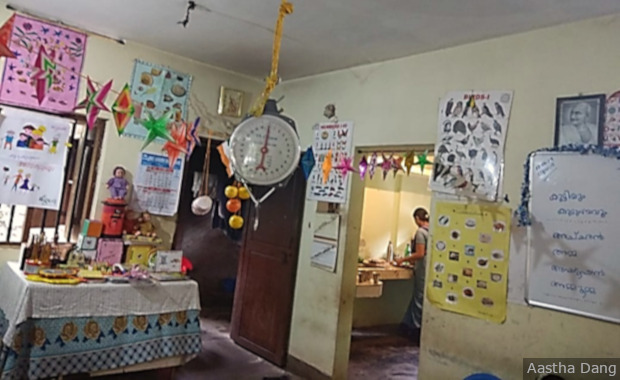
An urban anganwadi centre in Nettayam, in Kerala’s Thiruvananthapuram replete with informative charts and games made by the anganwadi worker, with some help from students and their mothers.
In both these states, supervisors assess anganwadi workers on performance, community participation, maintenance of infrastructure and other parameters. Those who display excellence in their work are given awards by the district collector and panchayat members. This creates a competitive environment. Since there is an emphasis on pre-school education, the anganwadi workers are referred to as ‘teachers’, which is a source of immense pride and validation for them, anganwadi workers told us.
Renudevi, 24, is an anganwadi teacher in the Nettayam block of Kerala’s Thiruvananthapuram district. A science graduate, she felt the need to give back to her community by working in the centre where she had received her formative years of education. “My mother was an anganwadi teacher and as a child, I also studied here,” Renudevi said. “After my mother’s retirement, I applied to work in this centre, since I had always aspired to be an anganwadi teacher.”
In neighbouring Karnataka, 60% of workers were reportedly dissatisfied with their job as were 91% in Odisha, different studies showed.
Delayed and low salaries are a major contributor to job dissatisfaction among anganwadi workers, an October 2019 study carried out in Bihar by researchers from development consulting firm Oxford Policy Management (2019) and the Institute of Development Studies in Sussex, both UK-based, revealed. In 2019, more than 70,000 anganwadi workers and helpers in Jharkhand went on strike for over 50 days to protest against poor salaries and lack of other benefits.
ICDS departments in Kerala and Tamil Nadu are women-led, which ensures close camaraderie among supervisors and workers, a supervisor told us. They are able to discuss critical issues with a sense of empathy. “We look forward to coming to work each day and enjoy meeting each other during field visits,” said Pushpalata, 44, a child development project officer (CDPO) in Tiruvallur, 45 km from state capital Chennai. “We are able to discuss issues freely since we have known each other for many years now.”
Comprehensive training for workers
Lakshmi*, 28, an anganwadi worker in Sriperumbudur, Tamil Nadu, described an activity conducted during the induction training: A puppet, denoting a child, was placed in the centre supported by sticks, each of which was held by an anganwadi worker. Each stick represented a different aspect supporting the child such as health, education and infrastructure. “Our trainer asked us to remove one stick at a time,” Lakshmi said. “Eventually, the puppet fell down, which implied that the child had died. It was a powerful exercise, and we were all in tears by the end of it. We learnt that if we did not do our job well and ensured that the anganwadis functioned effectively, it could result in the death of a child. We realised that we had an important role to play--we could save lives.”
Training of anganwadi workers is crucial to ensure that health and nutrition services are effectively delivered to the beneficiaries. Both Kerala and Tamil Nadu have a one-month induction course, during which representatives from health and other departments conduct courses.
A refresher training programme is conducted every two years and supervisors conduct in-situ training to address any gaps observed in the workers’ performance. Exposure visits to other anganwadis are encouraged for cross-learning.
Tamil Nadu has its own decentralised training system for grassroots level training. Each block has a training team that consists of five members. Kerala has one middle-level training centre for ICDS supervisors and 14 training centres (one for each district) for anganwadi workers and helpers.
In Tamil Nadu, the pre-school kit and the curriculum taught at the anganwadis is developed in consultation with teachers and representatives from Sarva Shiksha Abhiyan, a central government programme for the universalisation of primary education.
Teachers are equipped to enable activity-based learning in the classroom. They design activities and experiments to develop the children’s scientific temperament. For instance, in an anganwadi centre in Kancheepuram, piggy banks were used to inculcate the habit of saving in children.
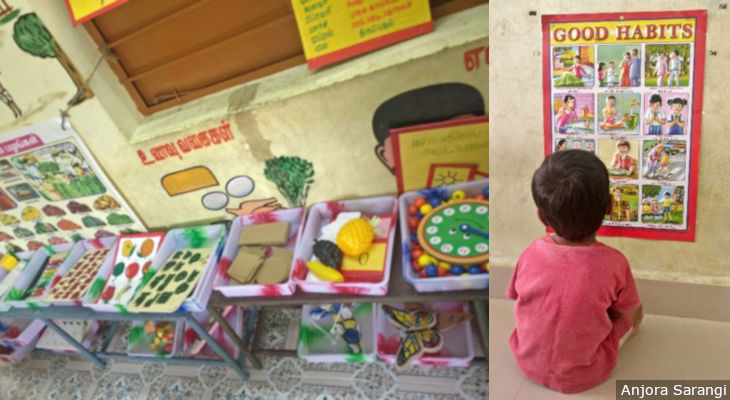
Left: The science corner in an anganwadi centre in Poonamallee block in Tamil Nadu’s Tiruvallur district. Right: A four-year-old reads a chart depicting ‘good habits’. Anganwadi workers in Tamil Nadu are equipped to enable activity-based learning in the classroom.
Revathi, 31, an anganwadi worker in Sriperumbudur block, described another activity: Each child is asked to go out and note the colour of the sky and the flowers, and any other things they may observe, and then come back and share their observations with the class. Once a week, children are also encouraged to describe the fruits which they get from home. “This small activity helps us to assess the child’s learning capacity and the task of acquiring knowledge becomes more scientifically embedded,” Revathi said. “At the same time, from the children’s point of view, learning becomes more fun.”
In Kerala, besides the state-held induction and refresher training programmes, community members such as retired school teachers are empanelled as master trainers, ensuring regular high-quality training for the workers in a resource-effective manner.
“After retirement, we feel this is a good way to contribute to society,” Bindu, 62, a master trainer in Thiruvananthapuram’s Aryanad village, told us. “We are able to use our skills to help make the local anganwadis a better place for learning and development for children.”
Kerala uses ‘teacher banks’ to tackle vacancies
Vacancies in India’s anganwadis affect access to basic nutrition and development services. In Bihar, 26,835 of 115,009 (23.4%) positions in anganwadis were vacant--the highest number nationwide. Kerala, by contrast, had 216 vacancies against 33,318 sanctioned positions (0.65%), government data for the year 2017-18 show. In this regard, Tamil Nadu is not doing as well as Kerala--it has 15,612 vacancies against 54,439 sanctioned positions (28.7%).
The ICDS in Kerala introduced the concept of a ‘teacher bank’ to counteract vacancies. On the basis of an interview process, a pool of interested candidates with the necessary qualifications is created at the village level. This pool serves to fill in for any imminent vacancy, which ensures smooth functioning of the anganwadi.
Engaging and mobilising communities
Community engagement is often neglected due to lack of motivation, relevant knowledge and training, studies have found.
In contrast, Kerala conducts social audits for its ICDS programme to measure, understand and report its performance in order to improve its functioning through the community’s involvement. Committees that consist of parents, adolescent girls, panchayat members and Accredited Social Health Activists (ASHA) evaluate indicators such as knowledge of anganwadi workers, infrastructure facilities and parents’ satisfaction. They conduct a village-level meeting in the presence of panchayat members, where a charter of demands is prepared and shared with the state department for improved accountability.
The state also has 3G (third generation) anganwadis where elders from the local community, children, as well as adolescents spend time, enabling interaction and co-learning amongst the three generations. Elders also conduct cooking and sewing classes for adolescent girls.
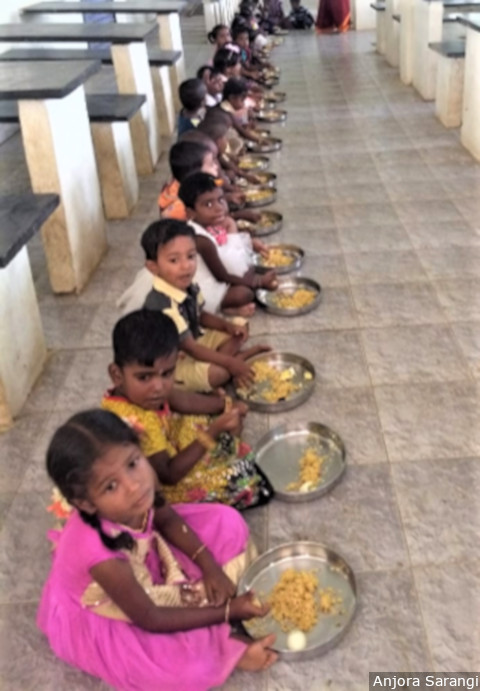
Children in an anganwadi centre enjoy a hot cooked meal in Sriperumbudur block in Tamil Nadu’s Kancheepuram district.
In Tamil Nadu, anganwadis organise programmes such as samudaya valaikappu (bangles ceremony in the community) for pregnant women in their last trimester. They encourage parents to participate in various programmes, which are used as platforms to create awareness and help instil faith in anganwadis.
The workers seek donations and aid from the community to enhance their services. They also form ‘mother support groups’ in each neighbourhood. Mothers assist in running anganwadis in case of leave or absence of the anganwadi worker and also encourage neighbours to send their children.
The Centre’s POSHAN Abhiyaan, launched in March 2018, emphasises the importance of community mobilisation for better awareness of nutrition. “Poshan Abhiyan is emphasising on community mobilisation, but we have been carrying out these activities for several years now,” said Malathi, the CDPO in Sriperumbudur. “For instance, initially, there was a lot of resistance around weight measurement of children in the villages. Community members did not trust us. We organised get-togethers in a village to screen a movie, did recipe demonstrations and spent time with them to gain their trust and induce a change in their behaviour.”
Families in rural areas are encouraged to set up kitchen gardens in their homes and send their products to anganwadis, Malathi, the CDPO, said. The vegetables and grains contributed by the community are used to cook meals for children. This process results in the dual benefit of community engagement as well as nutrition benefits for the child.
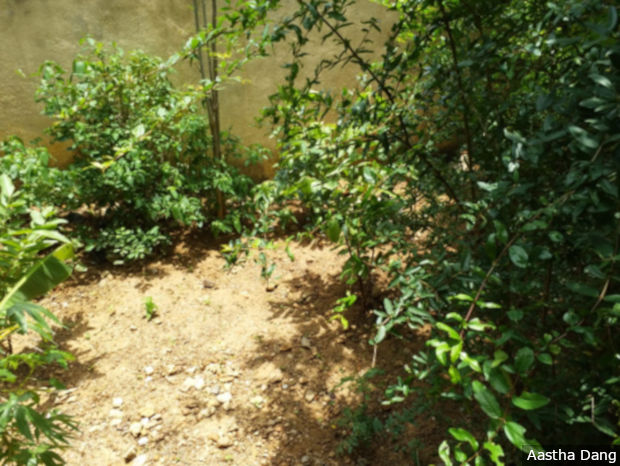
A kitchen garden in a rural anganwadi centre in Tamil Nadu’s Kancheepuram district. Families in rural Tamil Nadu are encouraged to set up kitchen gardens in their homes and send their products to anganwadis, where they are used to cook meals for children.
A bi-monthly newsletter called Chittukuruvi (sparrow) encapsulating best practices of various anganwadis is distributed among community members in Tamil Nadu. It carries nutritious recipes along with success stories.
Replicating practices across the country
The approaches of the two states may in part be attributed to their history of high literacy (80% in Tamil Nadu and 94% in Kerala as compared to the India average of 74%), social reform movements and strong political will to improve development outcomes. Kerala and Tamil Nadu’s success at providing public services has been attributed to their constructive state policies by economists Jean Dreze and Amartya Sen.
Yet, ICDS implementation in Tamil Nadu and Kerala is not adequately documented to allow their best practices to be implemented in other states. During our fieldwork, when a senior ICDS official in Kerala heard about our field visit to anganwadis in Tamil Nadu, she asked us to explain the differences from centres in Kerala, and what they could learn from the neighbouring state.
The Centre has attempted to document best practices from across states to promote cross-learning, but documentation is carried out through secondary sources such as newspapers, websites and articles, which do not highlight the detailed process of programme implementation.
*The names of ICDS officials and anganwadi workers mentioned have been changed to protect their identity.
(Dang and Sarangi are currently with Alexander Associates, New Delhi. They were engaged in a project to conduct primary research, and document learnings and best practices from health programmes across the country.)
We welcome feedback. Please write to respond@indiaspend.org. We reserve the right to edit responses for language and grammar.


